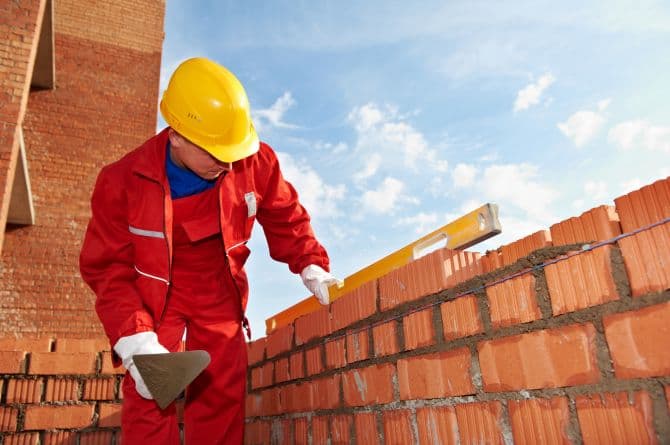5 Things to Know About Removing Interior Walls | Renovation Quotes
By Editorial Team
Updated on May 6, 2024

Knocking down the walls of your home might seem like an exciting project to take on. However, don’t get hammer happy just yet! Breaking down interior walls is a delicate process that must be completed carefully. Improper removal could cause the ceiling or roof to collapse, or lead to problems including issues with plumbing, electricity, gas and ventilation.
Make sure that you’re certain about wanting to remove a wall, and if so, this DIY project can be easily completed by even the most novice of homeowners. Of course, it is important to keep a few things in mind and therefore, read on to find out:
Removing interior walls
1- Load-bearing or not?
It is important to figure out how much weight a wall is carrying before moving forward with its destruction. The load-bearing capacity of a wall can be identified through its placement within a home or building. If the wall is close to the middle of the room and running perpendicular to the joists above, it is likely carrying a large amount of weight and is, therefore, probably a load-bearing wall.
If you can’t find the floor joists, they can generally be viewed from the basement or crawlspace. In addition, remember that a load-bearing wall on the first floor will extend up to the top floor of the house.
Load-bearing walls need extra attention if these are the ones you wish to remove. Posts, headers or even a temporary wall will need to be installed to replace these walls. The removal of load-bearing walls is best left to professionals, as although it is not a difficult project, a lot of heavy lifting is necessary. Further, to remove a load-bearing wall a permit may be required, so keep this in mind before donning that hard hat.
2- Check for plumbing and electricity

source: Pixabay, Pexels
Of course, the walls contain plumbing, electrical or ventilation vents for the heating or cooling system.
A relatively simple way to find out what your walls contain is to go to the basement, if it is accessible, and identify where the devices fit into the floor above.
You can also rely on the source; that is, take a small gypsum knife to create a few holes to scrutinize the inside of the wall. In addition to discovering electrical wires and plumbing, you will know if more important problems require your attention and if you need to delay the work or hire a specialist. This is sometimes the case in old houses.
If you discover that one of the walls you are removing contains only one of the elements mentioned above, it is necessary to proceed with caution. Your home's power supply should be turned off first and foremost. In addition, interior walls containing electrical wires or plumbing should not be cut down with a mass, but rather with a saw, cutting the gypsum gently, piece by piece.
If you don't know how to relocate electrical or plumbing devices, it's best to hire an engineer, electrician, or contractor.
3- Bear in mind the workload
Removing an interior wall might seem like fun and games once you’ve got the sledgehammer in hand, but as we’ve mentioned, this is a serious project. Taking out a wall can turn into a lot more work than was originally intended. Not only will the wall need to be attended to, but following this project the floor will likely need to be re-patched or depending on the damage, replaced.
If you’re working with hardwood, removing a wall is even harder, as patching hardwood floorboards is difficult, and this style of floor will still have to be refinished. Also, don’t forget to look up and take the ceiling into consideration! The ceiling will need to be tended to, patched and likely repainted.
It will probably be necessary to affix a lintel to it, repair it with a gypsum edge at the end and repaint it.
Planning such a project is half the battle. You will need to keep in mind that this project cannot be completed in an afternoon and that it must be given the time and attention it deserves. It will take at least two weeks; this does not include the time needed to repair the floor and the finishing touches on the ceiling. So, consider combining your renovation projects such as completely changing the flooring with removing the wall. Knowing this will also allow you to adjust your budget and schedules accordingly.
4- Space and size

source: Pixabay, nuc7ear
First, not every wall in your home can be removed. As we’ve mentioned, load-bearing walls are incredibly difficult to take down but often, it is difficult to determine whether a wall is load-bearing or not. This includes exterior walls, certain basement walls and walls running the length of your house. Except for exterior walls, which are load-bearing in most homes, the removal of walls will be case-specific.
Further, removing a wall in a one-storey home is quite different from removing a wall in a two-story home. If you are removing a wall in a two-story home, it is recommended that you speak with an expert, especially a structural engineer. When removing walls in a two-story home, excessive stress will be placed on the first floor.
5- Plan and prepare

To properly prepare the work area, consider protecting your furniture and other rooms from dust. Take out what you can, put tarps on the rest, spread old sheets on the floor and plug the doors by sticking a removable plastic on them. In addition to objects and living space, remember to protect yourself as well! Mask, goggles and gloves are required.
Then, after determining whether the wall is load-bearing and what it contains, draw the future opening with a pencil or directly with the help of a chisel and hammer. For plaster walls, you will only need to use a saw and remove the cut panels. If they are made of brick, stone, rubble or concrete, in short, a cinder block wall, you will need a disc chainsaw instead.
Finally, check with your local Ecocentre or municipality on how to dispose of debris in an environmentally friendly way. Consider even staying with a loved one or a hotel during this messy work!
Get 3 renovation quotes for your interior wall removal project
RenoQuotes.com can help you get quotes for your interior wall removal project. If you submit your project to us, we’ll put you in contact with top-rated contractors. Fill in the form on the homepage (it only takes a few minutes), and you will get estimates from trusted professionals.
Dial 1-844 828-1588 to speak with one of our customer service representatives.
Looking for something else?
Related articles
The latest industry news, interviews, technologies, and resources.

Cynthia Pigeon
•02 Aug 2024
When you start building or renovating your house, you’re faced with many choices, especially in terms of land location, the type of house you want (or have), the types of materials to be used, etc. Regarding the latter, it's imperative to select quality masonry materials to have a solid foundation, which will withstand heavy loads and the test of time. That said, are you looking to make an informed decision about which products to use? This article will allow you to get an overview of the types, brands, and prices of commonly used masonry materials.

Editorial Team
•07 Nov 2023
If you're looking to give your interior a modern look, concrete and concrete-inspired wall coverings are a great option. This article explains all the ways you can achieve a concrete look for your wall, with or without real concrete!

Editorial Team
•07 Nov 2023
Trying to manage the items of multiple family members is one of the many difficult tasks that running a household entails. Since the bathroom is generally the smallest room in the home, keeping it neat and tidy is a part-time job.

Léa Plourde-Archer
•03 Feb 2025
A home extension or addition is a significant upgrade that can add value and square footage to your property. However, what questions should you ask to ensure your project is executed flawlessly? How can you ensure the extension or addition blends with the rest of your house’s style? What should you know about materials, building permits, and associated costs?

Léa Plourde-Archer
•16 Jun 2025
Homeowners typically commission or carry out their home’s interior and exterior paintwork every four to five years—it all hinges on the humidity level, UV ray exposure (paint fades/discolours), and the house’s layout. Paintwork is one of the best ways of keeping a home looking fresh and aesthetically pleasing.